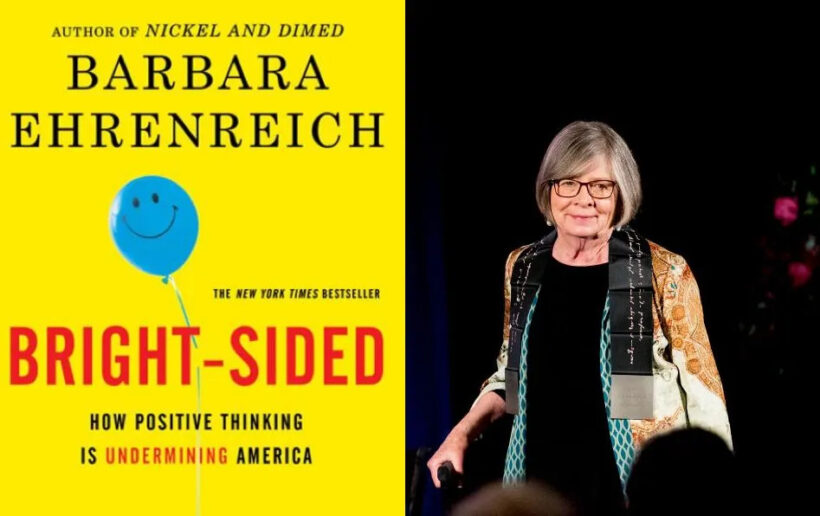We can thank the late economic justice warrior for her groundbreaking contribution in showing that “positive thinking” is part of a whitewashing of economic inequality.
By Sonali Kolhatkar
The Great Recession began in 2007. Two years later, in 2009, Ehrenreich published Bright-Sided. Two years after that, in 2011, the Occupy Wall Street (OWS) protests began in New York’s Zuccotti Park and spread throughout the country. OWS participants called damning attention to the stark economic split between the haves and the have-nots, in this case the wealthiest “1 percent” of Americans and the rest of us—the “99 percent.” There was no putting a smiley face on the economy in that moment.
It was during this period that I had the honor of interviewing Ehrenreich. She explained that “there is a whole industry in the United States that got an investment in this idea that if you just think positively, if you expect everything to turn out alright, if you’re optimistic and cheerful and upbeat, everything will be alright.”
Ehrenreich, who survived cancer, said she began her investigation into the ideology of positive thinking when she had breast cancer, roughly six years before Bright-Sided was published. That’s when she realized what a uniquely American phenomenon it was to put a positive spin on everything, even cancer.
When she looked for online support groups of other women struggling with cancer, what she found was, “constant exhortations to be positive about the disease, to be cheerful and optimistic.” Such an approach obscures the central question of, “why do we have an epidemic of breast cancer?” she said.
She applied that idea to how positive thinking was obscuring questions of economic inequality. And she found that there was an entire industry built up to assure financially struggling Americans that their poverty stemmed from their own negative thinking and that they could turn things around if they simply visualized wealth, embraced a can-do attitude about their bleak futures and willed money to flow into their lives. Central to this industry are “the coaches, the motivational speakers, the inspirational posters to put up on the office walls,” and more, said Ehrenreich.
She also connected the rise of the American megachurch to the rising cult of the positive-thinkers. “The megachurches are not about Christianity. The megachurches are about how you can prosper because God wants you to be rich,” she said.
Joel Osteen, the pastor of a Houston-based megachurch, is perhaps one of the best-known leaders of the so-called prosperity gospel. In one of his sermons—conveniently posted online as a slick YouTube video to reach a maximum audience—Osteen claims that according to “the scripture,” “the wealth of the ungodly is laid up for the righteous,” and that “it will be transferred into the hands of the righteous.” His congregants may be tempted to imagine bank transfers from wealthy atheists magically pouring into their accounts.
Osteen has been the beneficiary of serious wealth transfers from his own congregants into his pockets, so much so that he can afford to live in a $10 million mansion. There’s no conundrum here, for Osteen is living proof to his followers that the power of positive thinking works.
Ehrenreich pointed out that the whole point of these churches is to create a positive experience for their congregants and to project a notion of exciting possibilities. The megachurch phenomenon is centered on “the idea that the church should not be disturbing. You don’t want to have a negative message at church. So that’s why you won’t even find a cross on the wall.”
Perhaps this is because the image of a bloodied, half-naked Jesus Christ nailed by his hands and feet to a wooden cross is just too painful to bear and might detract from dreams of future Ferraris and private jets. “What a downer that would be!” exclaimed Ehrenreich.
Where did the cult of positive thinking originate? “American corporate culture is saturated with this positive thinking ideology,” especially in the 1990s and 2000s, said Ehrenreich. “It grew because corporations needed a way to manage downsizing, which really began in the 1980s.”
Businesses that laid off masses of employees had a message that Ehrenreich encapsulated as, “you’re getting eliminated… but it’s really an opportunity for you. It’s a great thing; you’ve got to look at this positively. Don’t complain, don’t be a whiner, you’re not a victim, etc.”
There may be a breaking point now, one that Ehrenreich thankfully lived to see, as a newer set of phenomena began emerging since the COVID-19 pandemic began. They include the “great resignation,” a term for masses of Americans quitting thankless jobs. And, more recently, “quiet quitting,” which is a new name for an older union-led idea of “work to rule” as workers are starting to only put in the hours they are paid to work and no more. How novel!
We owe Ehrenreich a debt of gratitude for shining a light not only on the perversity of the U.S. economic system but also on the gauzy veil of positive thinking that obscures the obscenity. Ehrenreich may not have lived to see her ideas of economic justice be fully realized. But, as she once told the New Yorker, “The idea is not that we will win in our own lifetimes and that’s the measure of us but that we will die trying.”
This article was produced by Economy for All, a project of the Independent Media Institute.
Sonali Kolhatkar is the founder, host and executive producer of “Rising Up With Sonali,” a television and radio show that airs on Free Speech TV and Pacifica stations. She is a writing fellow for the Economy for Allproject at the Independent Media Institute.










